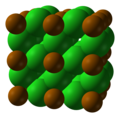
| |
| Identifiers | |
|---|---|
3D model (JSmol)
|
|
PubChem CID
|
|
| |
| |
| Properties | |
| PoCl2 | |
| Molar mass | 279.91 g/mol |
| Appearance | ruby-red solid[1] |
| Density | 6.50 g cm−3[2] |
| Melting point | 355 °C (671 °F; 628 K) (sublimes at 130 °C)[1] |
| Structure | |
| orthorhombic, oP3[2] | |
| Pmmm (No 47) | |
a = 0.367 nm, b = 0.435 nm, c = 0.450 nm
| |
Except where otherwise noted, data are given for materials in their standard state (at 25 °C [77 °F], 100 kPa).
| |
Polonium dichloride is a chemical compound of the radioactive metalloid, polonium and chlorine. Its chemical formula is PoCl2. It is an ionic salt.
YouTube Encyclopedic
-
1/5Views:2 231304 0842 80470 409160 121
-
Polonium
-
Polonium - Periodic Table of Videos
-
Could Polonium-204 Be Used as a Radiological Poison?
-
Easy polonium-beryllium neutron source: assembly, disassembly, and discussion
-
Making chlorine, bromine, and iodine 💛🧡💜 #shorts #chemicalreaction #periodictable
Transcription
Structure
Polonium dichloride appears to crystallise with an orthorhombic unit cell in either the P222, Pmm2 or Pmmm space group, although this is likely a pseudo-cell. Alternatively, the true space group may be monoclinic or triclinic, with one or more cell angles close to 90°.[2] Assuming the space group is P222, the structure exhibits distorted cubic coordination of Po as {PoCl8} and distorted square planar coordination of Cl as {ClPo4}.
Preparation
PoCl2 can be obtained either by halogenation of polonium metal or by dehalogenation of polonium tetrachloride, PoCl4.[1] Methods for dehalogenating PoCl4 include thermal decomposition at 300 °C, reduction of cold, slightly moist PoCl4 by sulfur dioxide; and heating PoCl4 in a stream of carbon monoxide or hydrogen sulfide at 150 °C.[2]
Reactions
PoCl2 dissolves in dilute hydrochloric acid to give a pink solution, which autoxidises to Po(IV). PoCl2 is rapidly oxidised by hydrogen peroxide or chlorine water. Addition of potassium hydroxide to the pink solution results in a dark brown precipitate – possibly hydrated PoO or Po(OH)2 – which is rapidly oxidised to Po(IV). With dilute nitric acid, PoCl2 forms a dark red solution followed by a flaky white precipitate of unknown composition.[2]
See also
References
- ^ a b c Holleman, Arnold Frederik; Wiberg, Egon (2001), Wiberg, Nils (ed.), Inorganic Chemistry, translated by Eagleson, Mary; Brewer, William, San Diego/Berlin: Academic Press/De Gruyter, p. 594, ISBN 0-12-352651-5
- ^ a b c d e Bagnall, K. W.; d'Eye, R. W. M.; Freeman, J. H. (1955). "The polonium halides. Part I. Polonium chlorides". Journal of the Chemical Society (Resumed): 2320. doi:10.1039/JR9550002320.


